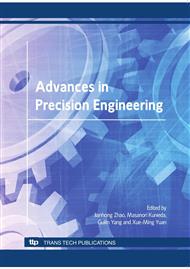p.26
p.31
p.36
p.41
p.46
p.51
p.55
p.61
p.66
Ultra Precision Machining of Non-Ferrous Metals and Nitrocarburized Tool Steel
Abstract:
This paper presents results for the machining of materials typically applied in ultra precision machining in comparison to a nitrocarburized tool steel. Analyzing and evaluating the machining results regarding surface integrity lead to recommendations for the ultra precision machining of this new mold material. The influence of feed, depth of cut and cutting speed on surface quality, resulting cutting forces and tool wear have been investigated. The results show that the decisive factor for the ultra precision machining of nitrocarburized tool steel are the significantly higher cutting forces. In some cases the high cutting forces lead to vibrations during the turning process deteriorating the surface integrity. Therefore, tool nose radius and depth of cut have to be reduced to minimize the cutting forces and avoid the vibrations.
Info:
Periodical:
Pages:
46-50
Citation:
Online since:
September 2010
Authors:
Keywords:
Price:
Сopyright:
© 2010 Trans Tech Publications Ltd. All Rights Reserved
Share:
Citation:


